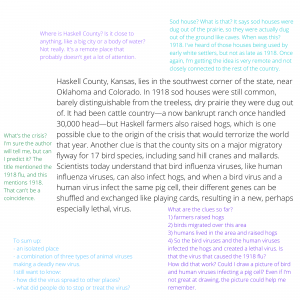6 Activity 1: How to Interview Your Book

Estimated time: 15 minutes
Objectives:
Students will be able to
- Use the strategies of close reading and 5W questions to gain a deeper understanding of texts.
Part 1: Introduction
Sometimes, especially if we aren’t strong readers or we are reading materials that are difficult for us, it’s easy to get caught up in decoding the meaning of what we’re reading sentence by sentence or even word by word. We may finish the text but not be able to easily recall details or answer questions.
We are often told that good readers engage with the text and ask questions when they read. But what does that really mean?
Part 2: What is an Interview?
You may not have conducted an interview before, so let’s go through the basic steps:
- Prepare. Find out about your subject or recall what you already know. Write questions.
- Ask questions. You made a list of things you want to know. Find and record the answers.
- Listen carefully. There may be information that surprises you, and it may lead to new and interesting questions.
Let’s look at a reading and try it out.
Part 3: Look at the Text
This is the first paragraph of an article called “How the Horrific 1918 Flu Spread Across America.” Keep the title in mind as you read.
Haskell County, Kansas, lies in the southwest corner of the state, near Oklahoma and Colorado. In 1918 sod houses were still common, barely distinguishable from the treeless, dry prairie they were dug out of. It had been cattle country—a now bankrupt ranch once handled 30,000 head—but Haskell farmers also raised hogs, which is one possible clue to the origin of the crisis that would terrorize the world that year. Another clue is that the county sits on a major migratory flyway for 17 bird species, including sand hill cranes and mallards. Scientists today understand that bird influenza viruses, like human influenza viruses, can also infect hogs, and when a bird virus and a human virus infect the same pig cell, their different genes can be shuffled and exchanged like playing cards, resulting in a new, perhaps especially lethal, virus.
If the author of the article were in the room with us, we could interview him and make sure we understand everything he was trying to tell us. Since he’s not, we have to interview the text. A well-written article like this one should answer all the important questions we have.
Reread the text and see how many questions you can generate. You’ve often heard the expression, “There are no dumb questions.” Keep that in mind and, no matter how basic or off-point the question is, write it down.
This is an example of how one student might interview the paragraph.

This image is licensed under CC-BY-NC-SA
This student asked a lot of questions. She also reviewed what she already knew and connected it to what she already knew before she started reading and what she learned during the reading process.
Journalists often use the 5W questions: who, what, when, where, why, and how (okay, it’s five Ws and one H). Try that with the same paragraph.
- Who? Farmers in Haskell County
- What? The development of the 1918 flu virus
- When? 1918
- Where? Haskell County, Kansas, USA
- Why? Bird viruses and human viruses combined in a hog cell
- How? I don’t know how the virus spread to humans. Was it through air? Was it through eating the hogs? I may have to read more to find out.
In this way, we can separate out the pieces that we know. We often find that we know more about the topic than we realize.

